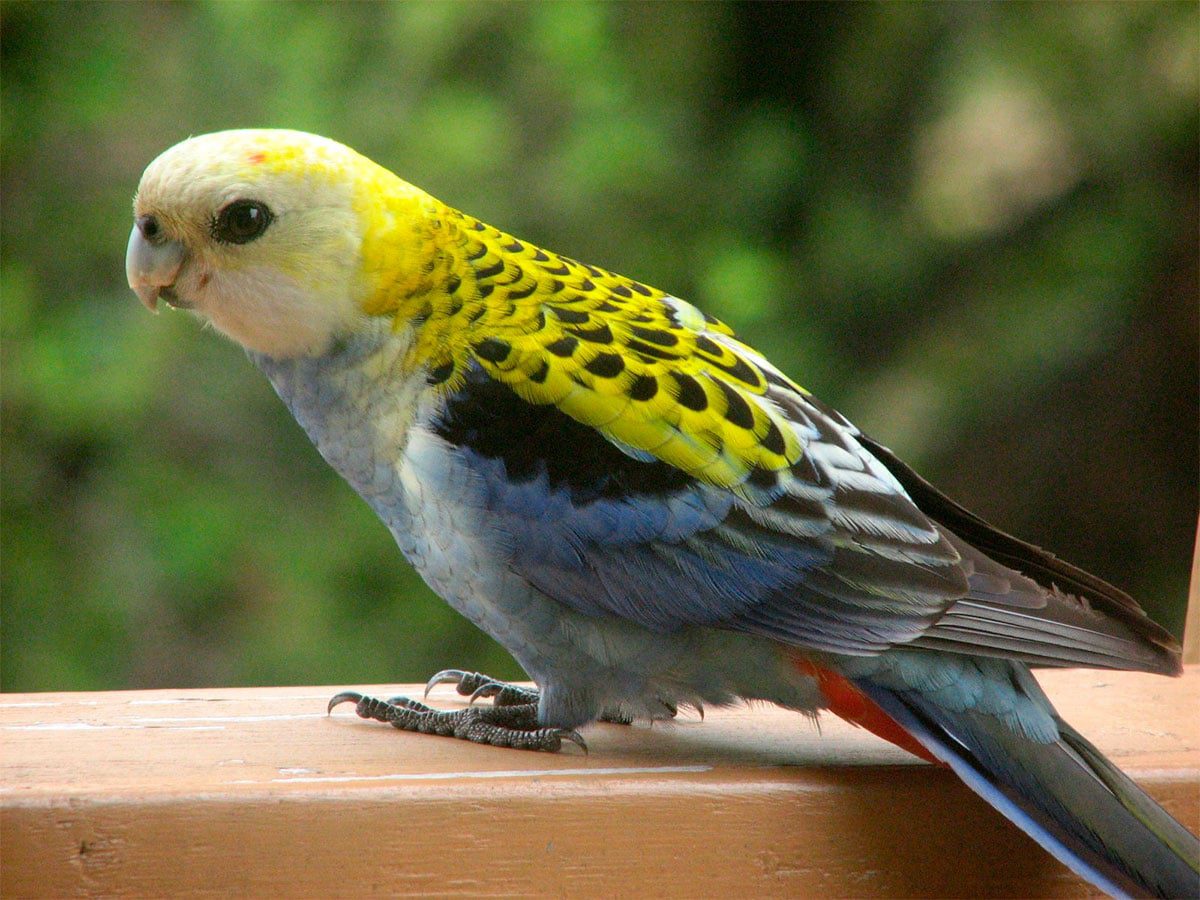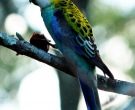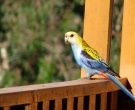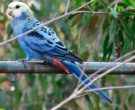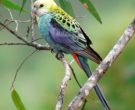Content
|
|---|
Description
30 cm.. length and a weight between 100 and 175 g..
The adult male of the Pale-headed Rosella (Platycercus adscitus), has the “head” pale yellow. The part superior of the cheeks is whitish in contrast with the part below that is of color blue light. Upper chest is yellow, the lower part of the chest and the abdomen are blue. The coverts They show a beautiful red hue. The the mantle, the back and scapulars are black with broad yellow edges, these areas giving a scaly appearance.
The tail is of color yellow uniform. The external coverts are dark blue. The central feathers of the tail are dark blue, but the outer feathers are more pale with thin white edges. The bottom has no stripe.
The bill is white. The irises They are brown, legs grey.
The female is different from the male, its color is more off and has a strip at the bottom of the wings.
The immature they have grayish feathers ending in yellow or orange-red at the top of the crown and the neck. The red feathers lose them about three months. The bottom of the wings is scratched. They acquire adult plumage in about 16 months.
- Sound of the Pale-headed Rosella.
Description 2 subspecies:
-
(Latham 1790) – The nominal
Platycercus adscitus adscitus
-
(Lear 1832) – 32 cm.. length. It is something most large that the nominal species. The white color of the face is more extensive, coming up to the neck. Crown, nape and ear-coverts are pale yellow. The blue of the chest presents tonalities yellowishwhite and the feathers of the chest they have a thin lined black. The shoulders with wide verdosa-amarilla blue staining. bottom of the flight feather white.
Platycercus adscitus palliceps
Habitat:
The Pale-headed Rosella they are common in all types of habitats of open forests, either scrub, scattered forests with logging, the rows of trees along rivers or swamps. They are also found in the wooded heaths which surround the coast and which are dominated by trees of the genus Banksia.
Avoid plunging into the thick forests, giving preference to the clear, meadows at the edges or directly border the plots. They also penetrate the surrounding farmland to feed.
They are birds of the lower regions, rarely rising above 700 meters and voluntarily leaving altitudes to the Crimson Rosella in dense forests and semi-montanosas areas.
Reproduction:
In the North, the Pale-headed Rosella They nest in the months of February to June, with some variations depending on the frequency of rains.
In the South, the breeding season are produced starting from September until the month of December.
These birds build their nests in deep a sick or healthy tree cavity, preferably a eucalyptus located near a river.
Other places that tend to choose are: a hole in a stump or a hole in a fence post.
The spawning generally includes between 3 and 5 eggs. The female incubates alone during 19 days, but as soon as the eggs are incubated, It receives assistance from the male that helps feed the young.
The chicks leave the nest after 5 weeks.
Food:
The Pale-headed Rosella they are mostly vegetarian. They consume a lot of plants, We have identified about 50 plant species. Similar to the Eastern Rosella, the Pale-headed Rosella It feeds mainly in the trees. The seeds of eucalyptus, acacias, Melaleuca, Black Cypress of Australia, acanthus and spiny Thistles, they are your favorite foods. The flowers and fruits some species also form part of their diet.
The Pale-headed Rosella they are often real pests for gardens and cornfields.
Distribution:
Size of the area of distribution (reproduction / resident): 1.470.000 km2
Confined to the East of Australia, where is dispersed through of the Cape York Peninsula, coming to the South up to the Gilbert River in the West, and extending to the South along the coast East of Queensland to the North of New South Wales.
In Queensland its inner boundary runs approximately through Croydon, Richmond, Lomgreach, Charleville and Bingara.
Are also distributed by the Fraser Island and around Brisbane, as well as in other coastal districts.
In New South Wales, the population is limited to the Northeast, extending toward the interior of Bourke and to the South up to around Coffs Harbour, on the coast.
Escapes have been recorded in Sydney and Melbourne, and there was an introduction without success in Hawaii at the beginning of this century.
The species coexists in the same altitude with the Eastern Rosella in the southeast of Queensland.
Common in suitable habitat within its range.
The world's population is above the 100.000 specimens.
Moderate numbers in captivity.
Fully protected.
Distribution 2 subspecies:
-
(Latham 1790) – The nominal
Platycercus adscitus adscitus
-
(Lear 1832) – Southeast of Queensland, to the South of the city of Innisfail, South to North of New South Wales (part-Eastern Australia) to the vicinity of the clarence river.
Platycercus adscitus palliceps
Conservation:
• Current category of the Red List of the UICN: Least concern
• Population Trend: Growing
The size of the world population It has not been quantified, It is estimated at around 100,000 specimens.
The species according to reports, It is abundant in much of their range (pit et to the. 1997).
They have benefited from the clearing of the forests and the development of fruit tree crops and agricultural fields.. But, an important limitation is that of its acquisition as a popular pet bird, marketed as Blue cheek parakeet. Each year, hundreds of birds are illegally captured in the wild.
"Pale-headed Rosella" in captivity:
common in Europe, not so much in the United States.
Active and moderately loud. Aggressive with other birds. A little susceptible to stress and disease.
Alternative names:
– Pale-headed Rosella, Blue Rosella, Blue-cheeked Parakeet, Blue-cheeked Rosella, Mealy Parakeet, Mealy Rosella, Moreton Bay Parakeet, Moreton Bay Rosella, Pale headed Rosella, White-cheeked Rosella, White-headed Rosella (ingles).
– Perruche à tête pâle, Perruche palliceps (French).
– Blasskopfrosella (German).
– Rosela-pálida (Portuguese).
– Perico Pálido, Rosela de Cabeza Pálida (español).
scientific classification:
– Order: Psittaciformes
– Family: Psittaculidae
– Genus: Platycercus
– Scientific name: Platycercus adscitus
– Citation: (Latham, 1790)
– Protonimo: Trained parrot
Images “Pale-headed Rosella”:
Videos "Pale-headed Rosella"
————————————————————————————————
“Pale-headed Rosella” (Platycercus adscitus)
Sources:
– Avibase
– Parrots of the World – Forshaw Joseph M
– Parrots A Guide to the Parrots of the World – Tony Juniper & Mike Parr
– Loromania
– Birdlife
– Photos:
(1) – A Pale-headed Rosella in Brisbane, Queensland, Australia By Paul Gear (Picasa Web Albums) [CC BY-SA 3.0], via Wikimedia Commons
(2) – Pale-headed Rosella (Platycercus adscitus) Kobble Creek, SE Queensland, Australia By Pale-headed_Rosella_kob02. JPG: Avicedaderivative work: Snowmanradio [CC BY-SA 3.0], via Wikimedia Commons
(3) – A Pale-headed Rosella in Herberton, Far North Queensland, Australia By Peter Shanks (originally posted to Flickr as pale headed rosella) [CC BY 2.0], via Wikimedia Commons
(4) – A Pale-headed Rosella in Brisbane, Queensland, Australia By Paul Gear (Picasa Web Albums) [CC BY-SA 3.0], via Wikimedia Commons
(5) – Pale-headed Rosella, Platycercus adscitus By Glen Fergus (Own work, Brisbane, Australia) [CC BY-SA 2.5], via Wikimedia Commons
(6) – A painting of a Pale-headed Rosella(originally captioned “Platycercus palliceps. Paleheaded Parakeet. In the pofsefsion of Mr. Leadbeater.”) by Edward Lear 1812-1888 Edward Lear [Public domain], via Wikimedia Commons
– Sounds: Judith Lattaway (Xeno-canto)
